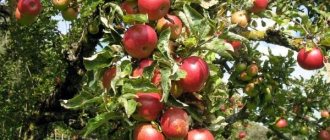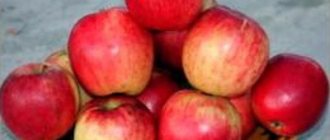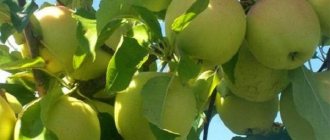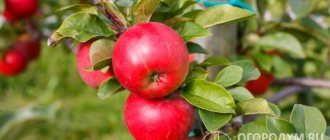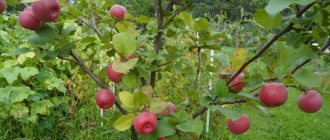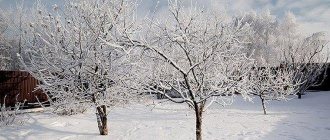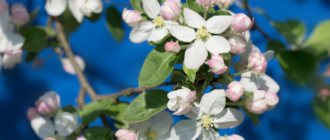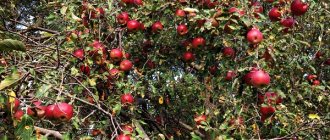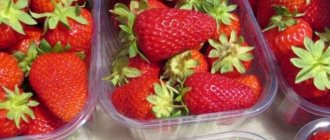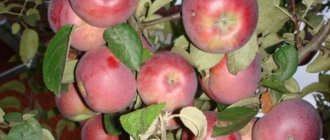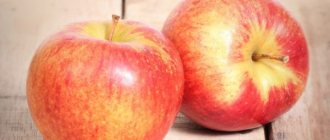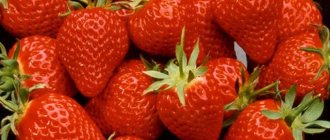Gardening » Apple tree
0
596
Article rating
Kira Stoletova
To grow a variety of fruit trees in different weather conditions, breeders are creating more and more new varieties. The Tolunai apple tree has large, juicy and bright fruits. Its peculiarity is that it is resistant to low temperatures.
Description of the Tolunai apple tree
Features of growing Dreams
Landing
Key Features
Good lighting is the main condition for growing trees of this variety.
Only in the sun will it bear a significant harvest of large fruits. In the shade, trees grow more slowly, bear fruit sluggishly, and the fruits grow very small. Sandy loam and loam are good soil options for an apple tree, but it will also grow well on black soil. The main criterion that must be checked is acidity. If it is increased, the apple trees may die. Close groundwater should not be close to the plantings, otherwise the Dream will definitely reach them with its roots and begin to rot. It is also not recommended to plant trees near rivers, lakes, ponds and even wells. Swampy areas or lowlands that are flooded with meltwater in the spring are also far from the best option for a tree. The pits are prepared in the fall, but you don’t have to do this. It is important to dig up the area a season before planting, fertilize it well and this will be enough. If you decide to do everything according to the rules, then dig holes 80 centimeters deep and the same in diameter, mix the top layer of soil with fertilizers and fill it to the bottom, lay drainage on top (gravel, stones, broken bricks)
All that remains is to fill it with 30-40 liters of water and leave it in the open air until the apple trees are planted. The distance between apple trees in a row should be about 2-3 meters, and the same between the rows. This is enough to ensure that the trees do not conflict with either their crowns or roots.
The root collar always remains 7-12 centimeters above the ground level - this is the law. If the seedling takes root higher, then all the original properties of the rootstock will be completely neutralized. The rhizome is inspected, all rotten, dry or diseased shoots are cut off with garden pruners. Immerse them in warm water for 6-8 hours. The seedling is placed vertically in a hole, directly on the drainage pile, holding it by the trunk with your hand. Cover with soil, compacting it with your hands so as not to clog the earthen ball too much. Water with 30-40 liters of water, the surface is mulched with humus, compost, chopped grass, and manure.
Disembarkation dates
The dream can be placed in open ground both in spring and autumn, when leaf fall has completely ended and the movement of sap in the trunks has stopped. However, experienced gardeners still recommend choosing the first option, since the survival rate when planted in late March or early April is much higher. The only thing that needs to be taken into account is return frosts, which should not damage the trees, so it is better to wait a little and not rush. Trees with a closed bark system can be planted at any time during the growing season.
Protection from frost and rodents
The high winter hardiness of a tree does not mean that you can leave it to the mercy of fate. In the southern regions, in the North Caucasus and Crimea, you don’t have to cover apple trees, but in all other places it is better to wrap the trunks with roofing felt, roofing felt, agrofibre, and throw mats of straw on the root area.
To repel rodents, trees to a height of approximately 1.2-1.5 meters are lubricated with rendered lard, grease or industrial preparations. To protect the trunks from insects, the trunks are whitened with lime twice a year - in spring and autumn, to the same height.
Tree care
Loosening the soil, watering: proper agricultural technology
It is not necessary to dig up the trunk circle of this apple tree. However, for ease of further care, it does not hurt to do this twice a year. At the same time, you can remove root shoots, shoots of other plants and weeds. You can hoe so that there is more oxygen in the soil, even once a month, if you have time, this will only benefit the tree
The main thing is to do all this carefully so as not to damage those roots that are located shallow below the surface.
Trees should be watered regularly in dry and hot weather, but not overdo it. Excessive flooding and stagnation of moisture at the rhizome must not be allowed, otherwise the decomposition process cannot be avoided. 4-6 waterings per season with a normal rainfall schedule will be enough to ensure normal fruiting. At the same time, you can add fertilizing and fertilizer.
Pruning: simple crown formation
The formation of the correct crown should begin from the first year after planting. Then the central conductor is shortened by one third, and only 2-3 skeletal branches are left, located in tiers far from each other. They should be 5-9 centimeters shorter than the main stem. The same form will need to be maintained annually, optimally in the spring, while sap flow has not yet begun.
Sanitary pruning, when all dry, damaged and diseased shoots are removed, can be done both in spring and autumn after harvesting. It won’t hurt to do anti-aging pruning starting around the age of 15-18. With them, 2-3 age branches are removed to give the young ones the opportunity to develop.
How to choose the right variety
When choosing a suitable apple variety, the following conditions must be taken into account:
- Climate. Not all winter species tolerate low temperatures equally well. Some species may begin to get sick, reduce productivity, or die due to severe frosts.
- The soil. Trees must be selected in accordance with the characteristics of the soil on which they will be planted. If there is a discrepancy, the apple tree may not take root or produce a low yield.
- Disease resistance. Not all trees have high resistance to typical apple diseases.
- Productivity. When choosing an apple variety, you should consider the purpose of cultivation. Not every winter species can produce crops on an industrial scale.
- Storage. Winter varieties have a varied shelf life. Some barely survive until the New Year, others can remain fresh enough until the next harvest.
- Commodity properties. Most winter apples have high marketability, but there are exceptions. If a variety is needed for sale, this should be taken into account before cultivation begins.
- Taste. The fruits of winter varieties can be sweet, sour or sweet and sour.
A little history
Apple trees migrated to Siberia along with settlers from more southern regions; they diligently tried to plant orchards in the developed territories.
But the severity of the climate reduced all their attempts to zero: the buds and flowers of apple trees, cherries, pears, and plums simply froze. Very often the entire tree died; in the spring there were no leaves on it.
It was then that scientists decided to develop completely new varieties that would be more resistant to the climatic conditions of this region.
The first hybrids had good frost resistance, but their fruits were the size of currants, and not everyone liked the tart-sour taste.
The first hybrid apple trees had small fruits.
Further crossbreeding resulted in varieties with larger fruits , but the tree itself became vulnerable in winter. The trunks did not tolerate frost and wind well, the yield gradually fell, and the trees simply froze.
success in this difficult task at the end of the 20th century ; in the 80s, several varieties of apple trees were developed that could withstand the excesses of the Siberian climate well, and the fruits were quite large in size and had a good taste.
APPLE TREE “MOON, 2 years”
Variety
— MOON Origin
- winter variety, obtained by crossing the varieties Golden Delicious and Topaz, Institute of Botany, Prague, Czech Republic, patented in 2005.
Rootstock
- medium-sized 54 - 118
Period of fruit consumption -
ripeness occurs in the first half of October, the harvest can wait until November for harvesting, storage - until April
The tree
is low-growing, the crown is evenly spreading.
Early ripening, abundant harvests, thinning of ovaries is recommended. The dimensions of an adult tree are 3 x 3 m. The fruits
are very large, up to 250 g, round, light green-yellow in color, with a blurred blush when exposed to sunlight.
The pulp
is dense, very juicy, crispy, with a dessert sweet taste with a slight sourness.
Resistance to diseases
- very high.
Winter hardiness
- very high
Main purpose
- consumed fresh, perfect for culinary products and baking. The variety is easy to care for and is especially resistant to scab.
• — Are you interested in this variety? Do you need more information? We are ready to answer your questions.
Write! Call! Consultation hours from 9:00 to 19:00
Please pay attention!
The first 20-25 days after planting the seedlings in a permanent place are key in terms of importance for the rooting of plants in a new place. The survival rate of young trees and shrubs in a new location and their further development largely depend on timely pruning and regular watering in the first three weeks.
Trimming.
Mandatory pruning is recommended for fruit plants. When planting, carry out post-planting pruning, leaving shoots no more than 40-45 cm long. It is also recommended to annually remove dry, damaged or fattening shoots, thinning, crown formation. Watering. Young plants REQUIRE regular, proper watering
For successful rooting of the plant, it is important that the soil is wetted not only from above (by 7-12 cm), but to the depth of the tips of the roots of the seedling (up to 35-45 cm). To do this, after planting during the first month, you must water the plant 2 times a week, 1 bucket per tree.
In dry times, it is recommended to increase watering to 1.5-2 buckets of water per plant 2-3 times a week. Mulching. To preserve moisture in the soil for a long time, it is advisable to use organic mulching of the tree trunk circle with a layer of 7-10 cm. Loosening. Regular, shallow. Weeding in the tree trunk circle. Important to remember! Lack of pruning during planting and irregular or insufficient watering in the first months after planting significantly reduce the percentage of plant survival in a new location.
Description of the apple tree variety Strela
It is unpretentious to soils and growing conditions, does not require special care and is resistant to infectious diseases. Recommended for growing in small areas near the home and in industrial intensive commercial gardens.
Apples: what they look like
The skin is dense, very elastic, but not very thick, smooth, glossy, very shiny. It is light green or greenish-light green in color, but as it ripens it becomes green-yellow or even golden. The integumentary blush is blurry-spotted, may be slightly speckled and streaked, dark red, burgundy, beetroot or with a slight purple tint, occupying at least 80-95% of the surface. Subcutaneous dots are light, very numerous, small, but clearly visible. The chemical composition is usually assessed according to the following indicators:
- P-active substances – 167 milligrams.
- Ascorbic acid (vitamin C) – 11.2 grams.
- Sugar (fructose) – 12.3%.
- Titratable acids – 0.86%.
- Pectins (fiber) – 15.3%.
The pulp is of medium density, pleasant consistency, slightly prickly, but at the same time tender, very juicy. It is fine-grained, fragile, has a slight greenish or yellowish tint, and can be a little creamy or lemony, depending on growing conditions, rootstock and other things. The taste is assessed by professionals as dessert, sweet and sour, balanced and harmonious. Apples score 4.3-4.5 points out of 5 for appearance and taste.
Apple tree Strela: characteristics
Crown and root system
The variety is a classic medium-growing column; it can easily reach 2.7-3 meters if it is not pruned in time. It grows as a single conductor, without releasing side shoots, which is why it got its name in the first place. The trunk is thick, covered with grayish-brown or green-brown, smooth and glossy bark without pubescence. It bears fruit on spears, ringlets and fruit twigs growing from the central stem.
The leaves are medium in size, deep green or bright green in color, glossy and shiny, smooth, leathery, rough nervation. They are elongated oval, with a serrated, slightly jagged, crenate edge, long-pointed, the tip can be tightened with a screw. The plate is often folded like a boat and may be slightly wavy. The root system is branched, little deep, poorly adapted to the search for moisture and nutrients, superficial, fibrous. Most often it does not have a central rod.
Productivity and pollination
The variety is classified as medium-growing and medium-yielding, since no record results can be expected from it. Although Strela is especially pleased with its stability from year to year.
The arrow is considered conditionally self-sterile. That is, most likely it will be possible to get a certain amount of fruits even if there are no apple trees of other varieties nearby that coincide in flowering time. However, there will be a meager number of them, so it is better to take care of pollinators in advance. Experienced owners bring mobile apiaries to the plantings, and the trees are sprayed with syrup from diluted honey or sugar during flowering.
Winter hardiness and disease resistance
The arrow is considered resistant to low temperatures, so it can easily withstand frosts down to -27-32°C. However, the tree will not receive damage only if it does not last long. If the winters in the region are harsh, and bitter frosts persist for at least 2-3 weeks in a row, you should take care of properly preparing and covering apple trees for the winter. Fortunately, the small height and special compactness of the crown allow all activities to be carried out without much difficulty.
Strela has a high degree of resistance to scab, powdery mildew, cytosporosis, pit buckwheat, bacterial burns and other diseases of apple trees. It is very rarely affected, and mainly the leaves are affected, while the fruit remains undamaged. However, we must not forget about prevention, because in years of severe epiphytotics it is definitely worth playing it safe and protecting the trees.
This fairly new variety does not yet have any subspecies, and they are extremely rare in columnar varieties. But Arrow can be grown on a wide variety of rootstocks, slightly changing the characteristics of the tree itself, and the fruits can only slightly change in size. Thus, on dwarfs and semi-dwarfs, the trunks barely reach 2-2.4 meters in height, the fruits are large, but cannot withstand even moderate frost down to -20-22°C. On seed rootstocks, the trees are more powerful, taller, and can withstand winters easier, but at the same time the apples are produced a little smaller, up to only 160-170 grams.
Description
Siberia is known to everyone for its frosty winters; the summer here is short, its duration does not allow many berries and fruits in the garden to ripen.
Fruiting apple tree Tolunai.
A number of frost-resistant fruit trees have been bred especially for this region, among which the Tolunai apple tree variety is especially popular in horticultural circles.
More on Tele4n.Net:
Apple tree Darunok: description of the variety and photos, reviews from gardeners
Advantages of the variety:
- The main advantages are considered to be the excellent taste of the fruit , sweet and sour, with a pronounced aroma;
- The variety is classified as large-fruited , which is rare for such a region;
- It has a summer ripening period, which allows you to enjoy apples from the end of August;
- Tolunay tolerates transportation and laying well . The taste does not change until the end of October, provided the conditions are met.
Disadvantages include average frost resistance for Siberia and intolerance to drafts.
The tree grows small , compact, and fits in well with the rest of the garden:
- The crown is round, requires periodic pruning, and is quite sparse.
- The branches extend from the main trunk at an angle of 45 degrees, stretch upward, and have a dark brown or brown bark color.
- The leaves are green, slightly rounded in shape with fine teeth along the edge.
- The apple tree of the Tolunay variety bears fruit mixed, starting from 4-5 years after planting. The first few years the yield is 5-6 tons per hectare of garden, the figure gradually increases, after 7-9 years up to 25 kg of the highest quality fruits are collected from each tree.
Advice! The first year after planting, do not let the apple tree bear fruit, even if it has bloomed. Just tear off the inflorescences, this will help it take root better.
Apples on the trunk usually grow in several pieces, each truncated-conical in shape. The surface is slightly ribbed, yellow in color with red or burgundy stripes over the entire surface of the fruit.
In cross-section, the fruit of the Tolunay apple tree has cream-colored pulp . The seed capsule is located exactly in the center; when ripe, the seeds are brown in color.
Tasting assessment showed that the fruits have excellent taste, juicy, aromatic, for which they deserved a rating of 4.8 points .
The apple pulp is soft and creamy.
The apple contains:
- 16.5% dry matter;
- 13% sugars;
- 0.4% acids;
- 11% of the total mass belongs to vitamin C.
On average, each weighs about 77 g, the maximum fruit of the variety grew to 130 g.
The Tolunai apple tree tolerates the Siberian climate well , but its frost resistance by local standards is considered average.
More on Tele4n.Net:
Apple tree Jubilee: description, photos, reviews
In severe frosts below 40 degrees, the following are subject to freezing:
- Bark,
- Top layer of wood
- Buds with flowers.
The variety is practically not prone to diseases, especially fungal ones.
Pest and disease control methods
The apple tree has many insect enemies, and the apple tree also suffers from diseases. It is necessary to fight them, because getting a good harvest depends on it.
hawthorn
This white-winged moth is very prolific. Damages apple tree leaves. One female can produce up to 500 eggs. Its caterpillars damage trees. In the spring, in order to control the pest, plants use: Karbofos, Phosfamide, Metaphos and other insecticides.
Hawthorn moth
Moth larvae also feed on leaves. While the buds have not yet opened, the trees are sprayed with Nitrophen to combat adult insects. The caterpillars must be destroyed before the trees bloom, by treating them with Karbofos.
Landing rules
In order for the tree to develop normally, you need to choose a place for growing where there is enough light, fertile soil, and water does not come to the very surface.
Landing dates
To remove dead parts, the roots of the apple tree are soaked and a phytohormone is added to the solution. Until the first frosts arrive, but the leaves have already flown off, young trees are planted. By spring they will get stronger and begin to grow. You can graft the Hornist hybrid onto an apple tree of another variety using the budding method.
Selecting a location
The fruit crop loves the sun, does not tolerate acidic and rocky soil, and grows strongly. To plant a tree, the area must be spacious and well lit.
Pit preparation
When the water is closer than 1.5 m from the ground, the roots of the apple tree will gradually rot. If there is no other place for planting, first make a small mound and make a drainage layer of crushed brick or expanded clay. A hole is dug about 60 cm deep and at least a meter in diameter, 2 buckets of compost or rotted humus, wood ash and superphosphate are poured onto the bottom.
Distance between seedlings
Tall apple trees are placed every 5 meters, since as they grow, they will begin to shade each other.
Planting process
The hole for the tree is dug in advance so that the soil has time to settle before autumn. It fills not all of it with the nutritional mixture, but half of it.
Before frost sets in:
- Install a wooden peg.
- Lay the top layer of soil in one direction, and the bottom layer in the other.
- The seedling is placed in the hole.
- The root collar is left above the ground, facing south.
- The apple tree is tied to a support.
- Cover with soil, which is compacted a little.
The tree is watered abundantly and covered with mulch. The plant will develop normally only if the neck is not buried. Otherwise, the apple tree may die.
Planting, agricultural technology, pruning
Apple trees are special for the Siberian region; their planting also has some nuances:
It is important to choose the right time of disembarkation. For this region, the most effective would be to plant a young tree in the spring, when the ground has not only thawed, but also warmed up well.
Advice! If the seedling was purchased in the fall, it should simply be buried to a depth of 5 cm. The trunk, branches and root system are additionally covered with peat and branches.
Disembarkation timing is important.
The soil in which the fruit tree will develop is very important. The Tolunai apple tree does not like acidic, clayey soils.
In addition, the drainage system is important, because in swampy areas during severe frosts, freezing often reaches groundwater, which injures the roots of the tree.
At such indicators, the soil is artificially made suitable. To do this, most of the soil is removed from the place where planting is planned. In its place, prepared mixtures are poured, which will allow the apple tree to take root faster and develop normally.
Important! Loam is considered the ideal soil; the apple tree is accepted faster and grows better. Minimal care will be required here - periodic fertilizing for good fruiting and resistance to diseases. Planting will require some preparation:
Planting will require some preparation:
First, dig a hole into which prepared fertile soil and fertilizers are poured. If the area is swampy, drainage made of small crushed stone or broken brick is placed at the bottom. A seedling is placed on the ground and the rhizomes are spread over the hole. The roots are sprinkled on top with a small amount of soil and compacted, but it is important that the place where the tree transitions into the root system remains above the surface.
After planting, the tree must be watered; about 30 liters should be distributed with a watering hose along the entire perimeter.
It is necessary to fertilize regularly, due to this, resistance to frost and disease increases.
When planting, the hole should contain:
- Peat;
- Humus;
- Superphosphate.
Before normal fruiting begins, nitrogen must be supplied regularly.
Watering for medium-sized varieties is not necessary, but in dry weather you can water the apple tree.
Pruning is necessary for a tree of any age:
- A crown is formed for a young seedling in this way and fruiting is increased. To do this, branches competing with the trunk are cut off completely, not even stumps are left.
- The first time the crown is cut evenly by 20-40 cm, the next trimmings are more gentle, 10-15 cm.
- Dry and broken branches are removed from mature trees throughout the entire period.
- There is no need to thin out the crown; Tolunay’s is sparse.
Pruning should be done for trees of any age.
The variety is open pollinated.
There are no particular difficulties in planting and subsequent care; the tree takes root easily.
Reviews from gardeners
According to the estimates of people who have already grown the Tolunai apple tree variety, many conclusions can be drawn. Some are surprised that such large, tasty and juicy apples could grow in Siberia. Their appearance pleases gardeners, because from the outside the apple tree looks cute, neat and small. Its branches are beautifully and evenly arranged, forming a beautiful crown.
The good news is that the tree is resistant to scab and other types of diseases and pests. It quickly takes root in the area and does not require vigilant care, and its yield is high.
In the Siberian climate, not all fruits and berries are able to ripen, so breeders are tirelessly working to develop new varieties adapted specifically for this region. The Tolunay apple tree is especially popular among both amateur gardeners and professionals.
Description of the apple variety Anis striped
Powerful hundred-year-old giants that still bear a lot of fruit often amaze foreign gardeners. Despite the small size of apples, as well as the insufficiently long shelf life, this Anise is recommended for growing in small garden plots, as well as in intensive commercial gardens.
Apples: what it looks like
The skin of the fruit is glossy, shiny, smooth, light green or light green in color; during ripening it is covered with an intense waxy coating, making the fruit bluish. The integumentary blush is speckled-striped, bright scarlet or simply red, occupying approximately 65-85% of the surface. Subcutaneous dots are light gray or greenish, large, few in number, and clearly visible. The easiest way to evaluate the chemical composition is by the following indicators:
- P-active substances (catechins) – 268 milligrams.
- Ascorbic acid (vitamin C) – 8.4 milligrams.
- Total sugars (fructose) – 11.5%.
- Pectins (fiber) – 14.8%.
- Titratable acids – 0.64%.
The pulp has a pleasant consistency, quite dense, fine-grained, and moderately juicy. It has an original, quite recognizable smell, as well as a sweet and sour taste, which is considered dessert, balanced and harmonious. The professional assessment of tasters for the Striped Anise (gray) variety is 4.6 points out of 5.
Apple tree Anise striped: characteristics
Crown and root system
The tree is considered medium-sized, although it can easily stretch up to 4.5-5 meters, and sometimes even more. However, most gardeners practice shaping to prevent excessive growth. The crown at a young age is cone-shaped, oval or broom-shaped, and tends to become very thick. The shoots are of medium thickness, geniculate, bent, covered with brown or brownish-brown bark, sometimes slightly pubescent. Fruits on ringlets and spears.
The leaves are medium-sized, round, elongated, leathery, dense, somewhat larger than those of Scarlet Anise. They are slightly shiny, although not glossy, have slight pubescence, a dark green or even emerald hue, with rough nervosa. The tips are long-pointed, the edges are finely serrated, crenate, and can be wavy. The root system is branched, quite powerful, of medium depth, and well adapted to searching for water.
Productivity and pollination
This subspecies of Anise, according to experts, is the most productive of all existing varieties.
The variety is considered conditionally self-fertile, which means that you will get some of the fruits even when there is not a single apple tree of another variety nearby that is suitable for flowering time. Bees and wind are enough for Anise, but it is better if there are such trees nearby. Then yields can be increased to the desired 100%. Many also recommend using mobile apiaries and spraying the garden with diluted honey or sugar during the flowering period.
Winter hardiness and disease resistance
All Anises react very adequately to fairly low temperatures. They do not show any special signs of freezing at temperatures of -37-40°C. But, even if the buds, young shoots or wood are damaged, the tree recovers very quickly and continues to bear fruit, as if nothing had happened. Therefore, the variety is very highly valued in particularly harsh regions, for example, in the Urals. But the tree cannot be grown in Siberia due to its height and the impossibility of sheltering for the winter.
Anise does not have immunity to powdery mildew, scab or other fungal infections. But their resistance is assessed by specialists at an average level; they are not prone to diseases, but can be affected by them. During the years of very strong epiphytoties, people get sick profusely and avalanche-like, so preventive measures must be carried out in a timely manner. The variety does not ignore insects, so insecticides should also always be in your arsenal.
There is a huge number of different subspecies of Anise, which are partially already described on our website. If they are not there yet, then similar material will be available soon. It is only worth saying that today there are many subvarieties that can be grown in the Far East, Siberia, the Urals, Tatarstan and Kazakhstan, Bashkiria and other regions that are no less difficult in terms of weather and climatic conditions. Striped anise is not yet suitable for these regions, but work with it is carried out constantly.
Description of the Tolunai apple tree
To grow a variety of fruit trees in different weather conditions, breeders are creating more and more new varieties. The Tolunai apple tree has large, juicy and bright fruits. Its peculiarity is that it is resistant to low temperatures.
Description of the Tolunai apple tree
Characteristics of the variety
Siberia has a short summer, which prevents trees, bushes and flowers from growing normally. Therefore, scientists tried to develop new hybrid forms of fruit trees that are resistant to harsh climates.
This turned out to be the Tolunai apple tree variety, which, according to the description, was discovered only at the end of the 20th century, in the 80s.
Description of the tree
The tree is neat and small. Its crown has a rounded shape, it is sparse, but requires periodic pruning. The branches of the tree are small, which is why it looks so compact. They grow from the trunk at an angle of 45° and are usually dark brown in color.
The leaves of the tree are light green in color, have a round shape, and its ends are pointed with small teeth.
Description of the fruit
The fruits of the apple tree are large, all truncated-conical in shape, and tend to grow on a branch in groups of 3-4 pieces.
One apple weighs from 90 to 110 g, the maximum weight is 130 g.
Their color is usually yellow, maybe with a golden or greenish tint. On the one hand, the apple has red or brown stripes. The cut reveals creamy flesh. It is fine-grained, soft and juicy.
The seed box is located right in the center, and the seeds of an already ripe apple are always brown.
According to the taste characteristics, the apple has a pronounced sweet taste with a slight hint of sourness (acidity - 0.4%). The big plus of the Tolunay apple is its distinct apple aroma.
Contains:
- sugar - 13%;
- vitamin C - 11 mg;
- dry matter - 16.5%;
The apple tree is winter-hardy, although in Siberia it is rated as average in frost resistance. All this is due to the fact that there are often low temperatures, somewhere around 40 ° C, the crown and branches of the tree tend to freeze. This can be easily corrected with the onset of spring, because... the tree recovers quickly.
Planting and care
The best period for apple tree propagation is spring.
In order for an apple tree to take root and produce a good harvest, it needs to be planted correctly. The best period for planting is spring (when the earth has already warmed up sufficiently).
If the procedure is carried out in the fall, the seedling only needs to be buried 5 cm. To prevent the tree from freezing, it is sprinkled with peat and covered with branches.
The soil is also important for the apple tree: it does not like acidic and clayey soil; a mixture with sand is more suitable. The best soil is loam.
Be sure to make a drainage system so that groundwater, which can freeze and harm the root system of the tree, drains away.
- For planting, the soil is specially prepared: excess soil where the tree should be is removed, and fertilizers are poured in its place.
- First, dig holes 40 cm deep. Prepared soil with peat, humus and phosphate is poured onto the bottom. For drainage, broken brick or crushed stone is poured onto the bottom.
- The seedling is placed on the bottom, its roots are carefully straightened and dug in so that only the root system is hidden.
Features of growing Baltika
Landing
Basic conditions
- As with all apple trees, you should choose a place for the variety that is well lit by the sun. In the shade, trees grow poorly, and the fruits grow small, sour and tasteless.
- The apple tree is highly resistant to cold and wind, but you shouldn’t think that it will do well in a constant draft. Therefore, it is better to choose a protected place, preferably a quiet one; if it is a slope, then it is southern or at least southeastern.
- The level of groundwater plays an important role. They should be no higher than 2.5-3 meters, otherwise the tree will definitely reach them with its roots and rot. Some manage to protect against this phenomenon by digging a sheet of slate or several layers of roofing material or roofing felt at a slightly higher depth.
- Baltika has no special complaints about soils; it grows well in both black soil, loam and even sandy loam. The main thing is that the acidity and salinity are normal; for the rest, proper feeding and fertilizer will help.
- It is optimal to prepare pits for planting in advance, in the fall or spring, but no less than 3-4 weeks before the start of planting. To do this, dig holes with a diameter of 1 meter and a depth of approximately 75-85 centimeters. A little soil from the top layer is poured onto their bottom, having previously mixed it with fertilizers, drainage is laid and filled with water (35-50 liters). They leave it all out in the open.
- The rhizome of the seedlings is inspected, all dry or damaged shoots are cut off, and immersed in warm water for 4-6 hours.
- The distance between the trees must be left sufficient so that the crowns and the branched powerful root system do not conflict with each other. It is optimal to make at least 5.5-6 meters between rows, and 5-5.5 meters between plants in a row.
- Immediately drive garter stakes into the hole; wooden ones are preferable, but metal ones are also possible. It is better to place them on the north side of the trunk, and they can be removed no earlier than 2-3 years after planting.
- The prepared seedling is placed vertically in the hole, holding the trunk with your hand, covered with soil, and compacted without getting too old. A small bank of soil is poured around the perimeter of the hole, it can be taken out from the depths, the tree is watered with 35-45 liters of water, the surface is mulched with straw, chopped grass, sawdust, and compost.
Disembarkation dates
Baltika can be planted in open ground, both in autumn and spring.
In the first option, it is worth waiting for the end of leaf fall, when the sap in the trunks freezes, but it is important not to wait for frost; there should be at least 2-3 weeks until frost, around the end of September or the beginning of October. In the spring you will have to make sure that the threat of return frosts has passed (late March or early April), and only then do planting work
Experienced gardeners recommend choosing the first option, because trees take root better this way.
Protection from frost and rodents
Despite the fact that the variety is resistant to various types of weather anomalies, it will still need to be covered for the winter. A layer of soil of 15-20 centimeters is raked onto the root zone, which will have to be removed in the spring. You can also cover the trees with straw mats, wrap the trunks with roofing felt, roofing felt and burlap. The height of young seedlings will allow them to be covered using the tent method, which cannot be said about adult trees.
To protect the trunks from rodents, the trunks can be lubricated with industrial products, or with ordinary melted lard or grease. Whitewashing trunks with ordinary lime to a height of up to 1.5 meters in spring and autumn helps against insects.
Tree care
Loosening the soil, watering: proper agricultural technology
Any plant loves fluffy, oxygenated soils, and apple trees are no exception. Therefore, twice a year you need to dig up the root area to allow the roots to “breathe”. In between, you can hoe the ground, at the same time removing root shoots, weeds and various other shoots.
Watering for the Baltic is not at all critical and often does not represent any need. If the weather is excessively hot and dry, and there has been no precipitation for 4-6 weeks, then you can add about 15-20 liters of water twice, in the morning and in the evening, this will be enough for her.
Pruning: simple crown formation
The tree is not prone to particularly thickening of the crown, so the first work on crown formation is usually started 2-4 years after planting. In this case, 2-4 skeletal branches are left, and the rest are removed, while absolutely everything, including the central conductor, is shortened by one third.
You should make sure that you do not remove more than a third of the entire green mass, otherwise the apple tree may get sick. The cut areas are covered with garden varnish or water-based paint. Dry or broken shoots that stick out into the crown or vertically upward should also be cut off regularly in autumn and spring.
Ripening and fruiting of the Rozhdestvenskoye apple tree
Beginning of fruiting
From the moment Rozhdestvensky is planted in open ground until you get several apples, you most often have to wait about 3 years, but the first more or less decent harvest will only be for 4-5 years. Then it will be possible to collect 5-10 kilograms of fruit from one tree.
Flowering time
The variety does not bloom equally everywhere, since this is influenced not only by the planting region, but also by the weather and other external factors. But mainly this occurs from mid to late May, and the flowering itself lasts 10-14 days. The flowers are large, collected in small umbellate inflorescences, white or pale pink with a pleasant but faint scent.
Fruiting and growth
It will not be difficult to wait for significant harvests. Already in 5-6 years, you can remove up to 50-70 kilograms of apples from a young tree. Although the tree’s growth is small, only 5-15 centimeters, by 8-10 years it is already fully formed, first increasing in height, and only then developing a crown. This often leads to mistakes when gardeners plant trees too densely.
To ensure that apples lay well, it is customary to pick them at the end of September. However, they can successfully remain on the branches until mid-October. But when they become overripe, there is a risk that they will fall to the ground on their own, in which case the entire harvest will need to be processed immediately. The shelf life of the fruits is very high and they easily retain all their consumer qualities until next spring.
Top dressing
- Manure.
- Mineral complexes.
- Bird droppings.
- A solution of wood ash with microelements.
- Superphosphate.
- Compost.
- Humus.
Features of maturation
The first harvest should be expected in 3-4 years.
Please note: if the flower stalks began to form earlier, they are removed to give time for the development and strengthening of the root system.
Productivity is on the rise, increasing every year. The full volume of the fruit is visible by 7-8 years and is about 25 kg. from one tree.
Apples ripen together, starting in mid-September. The fruits do not fall off and are shock-resistant. When manually assembled and placed in wooden boxes, they will last 40-45 days without loss of presentation and taste.
Apple trees: the two most scab-resistant varieties
Apple trees in the snow
Tolunay Katynova - jayaltalu kӱӱ chumdeechi
